
Alpaca - an extraordinary fiber

Sustainable & eco-friendly

Soft and cuddly

Exclusive & noble fiber

Thermoregulating

Durable for a lifetime

and
much more
The many qualities of alpaca fiber
Already since 4500 years the inhabitants of Peru love and wearing clothes made of alpaca. This has many reasons: Clothing made of alpaca is cuddly, silky-soft, and convinces with a unique sheen. Alpaca keeps you wonderfully warm when it is cold. Due to the hollow structure of the fiber, the air trapped in the micro combs acts like an air conditioner - it can thus cool at the same time when it is warm. Another plus is that the alpaca fiber is fine and wrinkle-resistant. It hardly forms any wool nodules even when worn in a demanding manner and is almost free of pilling. The alpaca fiber is antibacterial, stain-resistant, and therefore easy to care for - simply air out your favorite piece briefly after wearing it & wear wrinkles and odors dissolve directly into thin air. In addition, alpaca is hypoallergenic, a great advantage for those who are sensitive to wool.
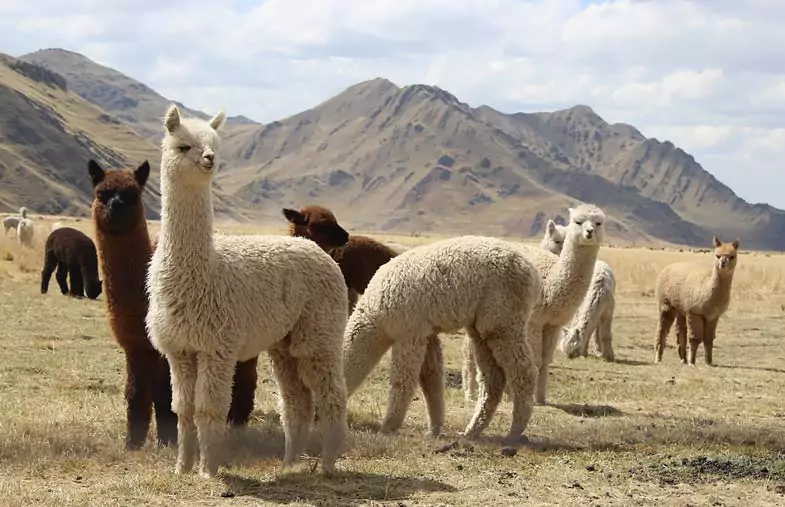
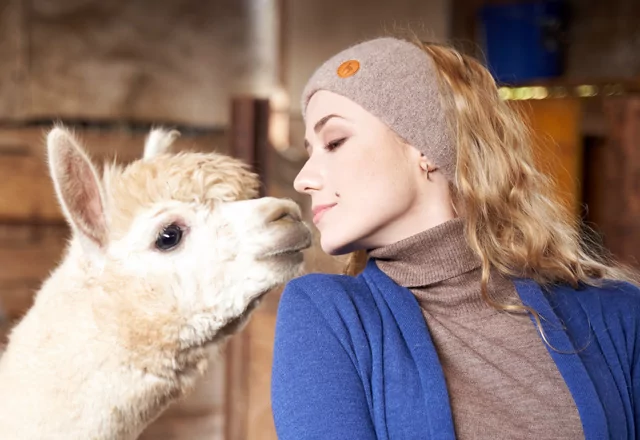
15 reasons to love alpaca fibers
- Thermoregulating: Warming in cold & cooling in the heat
- Soft & fluffy - without scratching
- Odorless & stain resistant
- Very durable & almost free of wool knots
- Easy to care for: Simply unhook - done!
- Fine and light to wear
- Free of wool grease, ideal for allergy sufferers
- From fair trade with Peruvian small farmers
- Alpacas graze freely & species-appropriate at over 3000 m
- Naturally available in more than 20 color shades!
- Sustainable & environmentally friendly - both the animal and the fiber
- Water repellent & sun resistant
- Garments last a lifetime
- Garments stay in shape
- No use of pesticides
Probably the most sustainable
natural fiber in the world
Alpaca is a sustainable, wonderfully soft, and super light natural fiber with optimal wearing properties. Even the animals live very environmentally friendly. Alpacas live in manageable family groups of 50 to 100 animals in the Peruvian Andes. They live outdoors all year round, their dense fur protecting them from temperatures as low as -20°C. Alpacas live at altitudes between 3000 - 5000 meters above sea level - remote areas that play little role in the rest of agriculture. Alpacas also live a soil-friendly life. When grazing, they only pluck off the blades of grass, allowing the plant roots to remain in the soil. Under their hooves, they have a soft sole pad. This allows them to graze even on the steepest slopes without destroying the soil. Alpacas are sheared only once a year - gently by the hand and in a manner appropriate to the species. The cleaning of alpaca fibers requires much less energy and chemicals compared to other animal fibers.
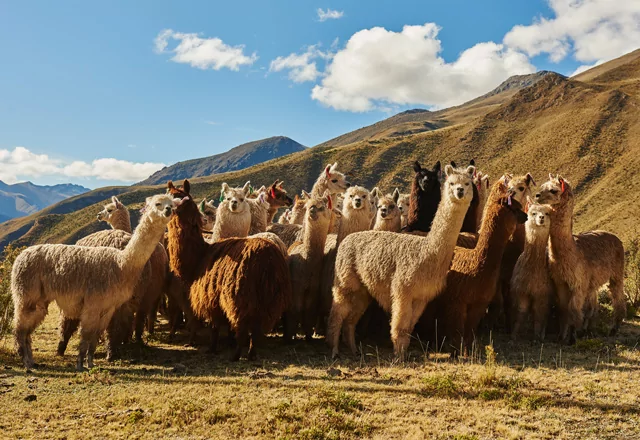
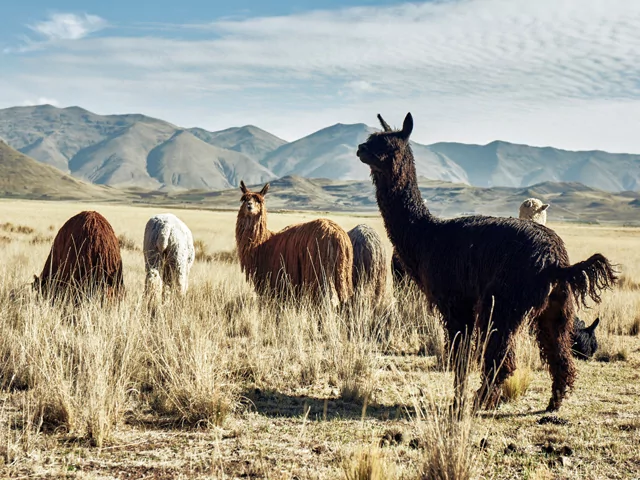
The most beautiful and durable fiber
in 22 natural shades
The alpaca is the only animal that has about 22 different natural shades (up to 60 color shades) in a soft, beautiful, and also durable fiber. The spectrum ranges from pure white to black, including various shades of brown and gray. This often saves environmentally harmful dyeing processes.
Due to the changing demand of the textile industry, natural colors, which do not require dyeing, have received more attention in recent years. The white fiber can nevertheless be dyed according to international trend specifications.
In addition to the variety of colors, the fiber has a high product quality, which is due to the long acclimatization process of the animals in the Andes. To withstand extreme temperature changes, the alpacas developed a fine, lightweight fleece that is water repellent and sun resistant. No other natural and noble fiber has such a combination of quality.
Where does our alpaca wool come from?
Our alpacas also live in small family groups in the Peruvian Andes. Thousands of small farmers who live from alpaca breeding lovingly care for their animals and keep them outdoors all year round, including plenty of exercises. Traditionally, shearing takes place once a year for each animal and lasts only a few minutes. The fibers are then sorted by hand according to color and fineness. Traditional selection is a demanding craft that only a few people have mastered. Our alpaca wool is processed in our production facilities in Cusco (Peru) and Lima (Peru).
Due to the small number of animals, alpaca is very rare and its share of the total fiber supply worldwide is only about 0.1%! The share of the particularly fine qualities such as "Royal Alpaca" or "Baby Alpaca" is even lower.
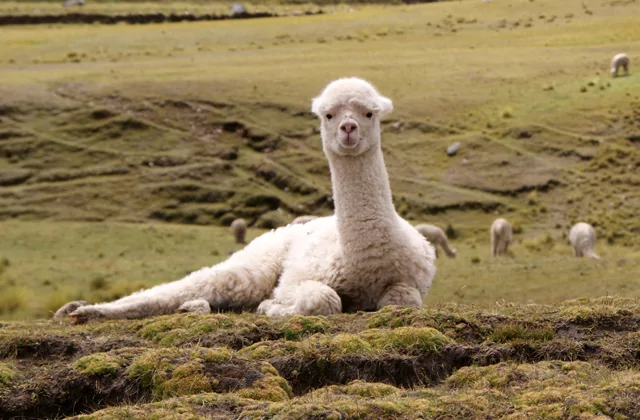
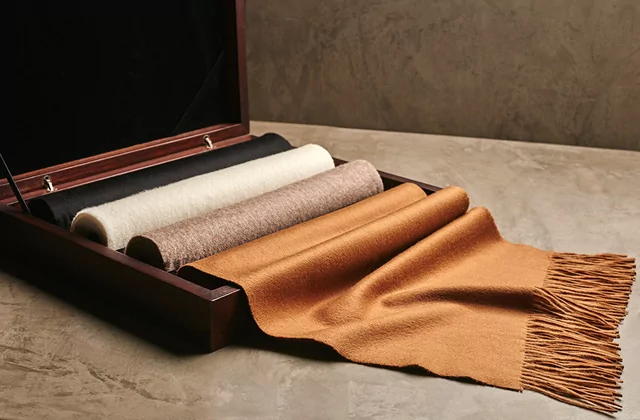
Vicuña wool is the softest
and most luxurious wool in the world
The name "alpaca" has become synonymous with fine, high-quality wool used in the elegant world of haute couture. It is one of the warmest (up to 7x warmer than sheep's wool) and finest, which despite its warmth properties is also very thin, light, and elastic, allowing it to adapt to all body shapes. Alpaca wool is surpassed only by vicuna (also: vicuña) - the wild relatives of alpacas. There are only 200,000 vicuñas in the world. Their fiber has an average micron rating of only 11 - 13.5. The wild vicuñas are captured and sheared every two years, and approximately 150 grams of fine fiber can be obtained per animal. Due to this extreme rarity, a pair of socks already cost several hundred euros and a vicuña sweater over €1,000. Exclusive vicuña offers are available in our online store.
Alpaca has a special cell structure of fibers. This consists of different scales that interlock. The step of the individual scales is called "scale height". This scale height is about 0.4 microns for alpaca fiber; about 0.8 microns for sheep's wool. The greater the scale height, the more uncomfortable and scratchy a fiber feels against the skin and the more likely it is to mat. In addition, alpaca contains almost no lanolin (wool grease), which is why it feels so fluffy. Another advantage is that time-consuming dry cleaning, as required for sheep's wool, is not necessary and the processing of the fiber is enormously facilitated. Even freshly sheared alpaca wool feels completely dry and fluffy and, depending on how dirty it is, does not need to be cleaned at all. Another reason is the fineness of the fiber. Alpacas are among the finest fiber animals in the world. The fineness of the alpaca fiber or wool is measured in "microns". This is a measurement of the diameter of the animal's hair.
The lower the micron value of a fiber, the softer the fiber feels and the finer and higher quality the garment will later be. There are different fineness classes, but we always use only the three finest alpaca hairs - royal, baby, and superfine alpaca. The alpaca fibers we process have a fineness of 19 - 27 microns (i.e. micrometers), which corresponds on average to between 0.019 - 0.027 millimeters. This wonderful fineness is one reason for the many advantages of alpaca fiber.
For comparison, human hair has a thickness of 70 microns (0.07 millimeters).
At a glance:
- - Today, this exceptional fiber plays a fundamental role in the world of textiles
- - High performance in extreme weather conditions
- - Incredibly soft to the touch
- - Wide range of products
It is a fiber known worldwide for its softness and subtle luster. Baby alpaca has the greatest chromatic diversity that exists in the world of weaving - 22 natural shades that go from white, brown, and gray to black.
Through the experienced hands of artisans who still know the ancient secrets and which fibers to choose by hand, baby alpaca gets its exquisite quality and an average fineness between 20 and 22.5 microns. Besides its warmth and softness, the inspiration and basis for the development of Andean textiles were mainly the Incas.
At a glance:
- - Delicate sheen
- - Exclusive selection
- - Unsurpassed softness
- - Limited and numbered products
The finest alpaca garments in the world.
The finest selection of alpaca fiber ever won is called Alpaca 16, which is unbeatably soft to the touch and has a subtle sheen. The fiber comes from the National Alpaca Fiber Competition held annually at KUNA's Experimental Station for Scientific Research and Genetic Development: Pacomarca. It has a fineness of 16.7 microns, a world record for alpaca fiber that has never been achieved before and that only KUNA possesses.
The production of Alpaca 16 belongs to a small batch made up of fibers from the best alpaca breeders in Peru, finalists in the competition "El Quintal del Inca", which allows 100% traceability. Therefore, each item is numbered.
At a glance:
- - Subtle sheen
- - Silky in appearance
- - Beautiful uniqueness
- - Incredibly soft to the touch
Royal Alpaca is the most sophisticated selection of the best alpaca fibers from both breeds (Suri and Huacaya). Performed by expert hands of artisans who have mastered ancient secrets and later by a mechanized process that allows them to choose the finest fiber. Soft and warm, with that elegant and subtle luster that also includes the magnificent range of tones that this wonderful fiber can offer. All this makes it possible that the garments made with this material have an unmistakable elegance and personality.
KUNA guarantees that ROYAL ALPACA yarns come from fleeces of maximum fineness (up to 18 microns) and offer a feeling of comfort comparable to that of other very fine hair such as cashmere, camel, extra fine wool, etc.
At a glance:
- - Exclusive and very limited selection
- - Numbered pieces
- - 100% natural black fiber
- - Of high fineness and uniformity
- - It symbolizes KUNA's efforts to preserve the black alpacas
The rarest natural fiber color in the world is black, and Peru is the country with the highest number of black alpacas. However, the number of pure black alpacas in Peru has dropped to about 5,000 animals in recent years.
BLACK ALPAKA is a fascinating and exclusive collection that symbolizes KUNA's effort to preserve pure black alpacas, which are currently threatened with extinction. Thanks to Pacomarca we can say that KUNA has the largest existing group of these animals, which they study, care for, and propagate to promote their breeding in the rest of the country.
At a glance:
- - Beautiful uniqueness
- - Silky in appearance
- - Incredibly soft to the touch
- - Exclusive and of countless qualities
The Suri breed represents only 6% of the total population of alpacas. It produces a very fine fleece that covers it like a coat, made up of long wicks up to 16 cm long; this fall vertically on the neck and around the entire body, giving it a unique beauty.
It is the crowning glory of the selection of alpaca fibers since only 0.5% of the total alpaca fiber processed corresponds to this noble input. BABY ALPACA SURI is one of the most precious fibers of the South American camelids, thanks to its beautiful variety of colors, its fineness, its softness, and its natural shine, which gives a visible and very special elegance to the garments.
At a glance:
- - Hypoallergenic
- - Silky in appearance
- - Incredibly soft to the touch
- - Thermoregulating properties
The guanaco produces a very fine fiber of a delicate cinnamon color. A warm and silky raw material, it is used by KUNA to make garments that, in addition to their excellent quality, have an unusual charm related to the evolution of Andean man, who, like the vicuña, uses the chaccu as a shearing method for this animal.
Today, KUNA painstakingly collects guanaco fibers certified by CITES in a wide area of the Andes. These fibers are hand-selected to ensure that their luster and special softness are of the highest quality. This makes it possible to produce garments of refined beauty that preserve the unique charm of nature.
Marketing of fibers certified by the Peruvian Ministry of Agriculture and Irrigation and CITES (Convención sobre el Comercio Internacional de Especies Amenazadas de Fauna y Flora Silvestre).
At a glance:
- - Hypoallergenic
- - The Peruvian national symbol
- - Considered "the gold of the Andes"
- - Its fiber varies between 11 and 13.5 microns
- - Lightweight and with thermoregulatory properties
- - The marketing of its fibers is certified by the Peruvian Ministry of Agriculture and Irrigation and by CITES (Convención sobre el Comercio Internacional de Especies Amenazadas de Fauna y Flora Silvestre)
The most beautiful of the South American camels, this wonderful animal with the finest animal fiber in the world, served the ancient Andean weavers as the most valuable raw material from which they made wonderful clothes for the Inca kings.
Vicuñas are shorn only every 2 years on the back and sometimes on the neck. The ancestral knowledge of the Andean communities is used to obtain the fibers, through the shearing method called Chaccu, which makes it possible to obtain this valuable fiber while preserving the integrity and freedom of this wonderful animal. The yield per shearing and animal is only 125 to 150g. Of this, 43-47% of the best fibers are sorted out by hand. Likewise, it is the heritage of these communities that manage to keep intact the qualities of this fiber, as they perform a delicate descerdado by hand. An infinite effort that pays off for this incomparable quality.
Vicuna is so rare, yet so fine and soft, that even the world's greatest couturiers go into raptures over this fiber. No wonder, because this fiber may only be processed by three manufacturers worldwide. And only a few of them have the chance to use yarns and fabrics made of vicuna for their exquisite collections.
KUNA has taken on the fascinating challenge of ensuring the survival of vicuña and its rich heritage by employing thousands of Peruvians from KUNA and being the only brand in the world that follows the production process from start to finish. They transform the extremely fine vicuna fiber into garments of delicate beauty, whose softness to the touch is a privilege that fills with pride.
Comparison alpaca - cashmere
Two luxury fibers - that's no question. However, alpaca fiber can surpass cashmere in some respects: Thermal insulation is better with alpaca fiber than with cashmere. Alpaca warms when it is cold and cools when it is warm. In addition, the fiber is lighter than cashmere due to the hollow space. Cashmere is very prone to fluff and lint, this effect is much less pronounced or non-existent in alpaca. The reason is the length of the alpaca fiber. Alpaca contains almost no lanolin (wool grease) and is therefore suitable for allergy sufferers. Alpaca is stronger and more resistant and does not become thinner even through industrial processing. Therefore, the garments last for years. Alpaca fiber is longer than cashmere and does not mat as quickly. In addition, the nodules (pilling) generally known from wool remain absent. Cashmere is rare, but alpaca is even rarer. The world production of cashmere is about 14-15,000 tons, whereas there are only about 4,000 tons of alpaca fiber.
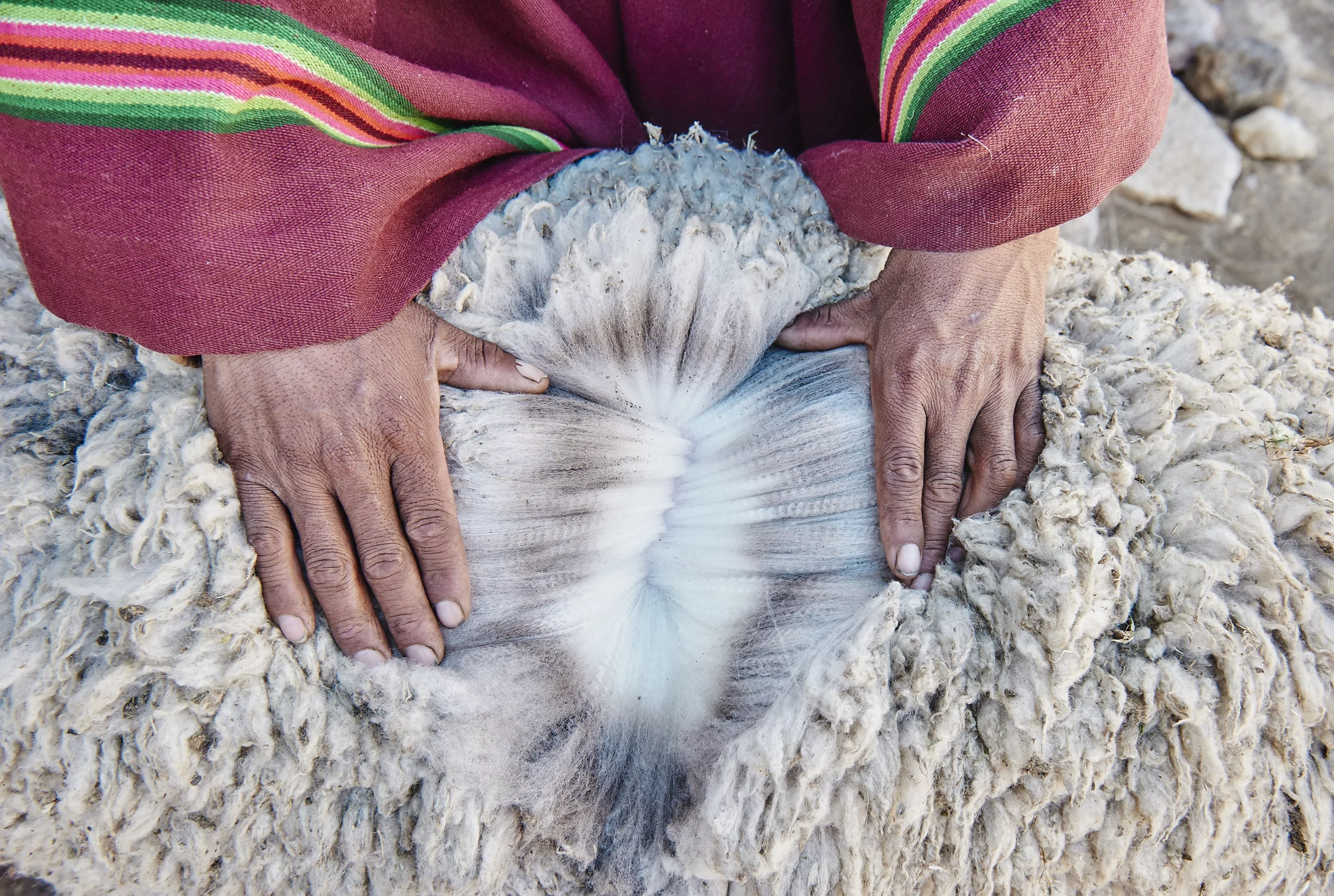
Animal fibers
All natural fibers can be assigned to either the animal or the plant fiber group. The two fiber groups differ according to their origin (animal or plant) and consequently also in structure, composition, and properties. Animal fibers consist mainly of protein and are often referred to as protein fibers. Besides silk, all kinds of animal hair belong to this group. In general, animal fibers are warmer, require less cleaning, and are more fungus-resistant than plant fibers.
- Fluffy, warming, and light
- Well suited for winter sweaters and other cozy garments - The degree of piecing depends on breed, origin, and processing
- Can absorb up to 1/3 of its weight in moisture without feeling wet
- elf-cleaning function due to fiber structure
- Airing out is usually sufficient Can be very elastic
- Kann sehr elastisch sein - 18-45 microns
- Naturally contained lanolin
+ slightly water repellent
– Problematic for allergy sufferers/people with sensitive skin - Larger scale height than alpaca = more likely to scratch than alpaca
- Cheaper alternative to cashmere
- Between 16 and 25 microns fine
- Average around 20 - Has similar properties to cashmere
- Even in the thickest grade, still soft enough not to scratch
- Often used for baby clothes or blankets - Also often used for sportswear
- Property of not absorbing sweat odors so easily -> airing out neutralizes the odor again - Dirt and water repellent in a natural way
- Still warms when moist
- Greater shed height than alpaca = more likely to scratch than alpaca
- Fluffy softness
- Can be processed almost 100%
- 13-18 micron
- Fibers hollow inside
- Retains heat particularly well - Said to have healing properties
- Rheumatherapy blankets/health underwear - Fluffy at the beginning
- but settles with time - Attitude & extraction problematic
- chin. Fur farms
- animal husbandry
- shearing of the animals
- Special case: does not consist of shorn hair, but is produced by an animal
- Consists of one thread (endless thread) - Very tear resistant
- Does not scratch at all and is very smooth
- Does not have any protruding hairs or hair scales
- Natural shine
- Feels very soft and cool to the touch
- Can be very cooling and comfortable in summer
- Beware of (sweat) stains
- Little dimensional stability
Here you will find the most frequently asked questions about alpaca fiber
Where does our alpaca wool come from?
Our alpacas live mostly in small family herds of 50 to 100 animals in the Peruvian Andes. There are thousands of small farmers who live from alpaca breeding, lovingly care for their animals and keep them outdoors all year round. With plenty of outdoor space included. The shearing traditionally takes place once a year per animal and lasts only a few minutes. Afterwards, the fibers are manually selected according to color and fineness. This traditional selection is a demanding craft that only a few people have mastered. Our alpaca wool is further processed in our own production facilities in Cusco, Arequipa and Lima in Peru. Here we guarantee fair wages, secure jobs and above-average social security. Would you like to learn more? For more information about the fair and sustainable production facilities of the brands APU KUNTUR and KUNA please visit the two manufacturer pages here in the store.
Do we really use the wool from alpaca babies?
No, of course we do not use the fibers of baby alpaca. The term baby alpaca is the name of one of the highest quality grades of alpaca. Baby alpaca refers to extremely fine and high quality alpaca fibers. These are so incredibly fine that they would normally only be found in the very youngest alpacas. To belong to this fineness class, the average hair must be no thicker than 22.5 microns (also called microns). This high fineness provides for many incredibly great wearing properties - for example, the silky sheen, the high durability and the light feel.
Why is alpaca wool especially suitable for allergy sufferers?
Our alpaca range is particularly suitable for allergy sufferers! Alpaca wool contains hardly any wool fat - so-called lanolin. Lanolin is an animal fat found in sheep's wool and can be irritating to the skin. However, since alpaca wool is almost completely lanolin-free, it is ideally suited for allergy sufferers, babies and people with sensitive skin. Our alpaca sweaters, cardigans, scarves, hats, gloves and even the thermal underwear can therefore be worn quite safely.
How do I properly care for my alpaca products?
It is very easy to properly care for alpaca clothing. Alpaca is stain-resistant and antibacterial. The superfine structure ensures that odors are absorbed extremely slowly and ideally disappear quickly. If you want to give your alpaca sweater freshness again after wearing it, simply hang it out on the balcony or in the bathroom to air it out - instead of washing it completely. After just a few hours, any odors as well as wrinkles will disappear without a trace! In addition, the alpaca fiber is very durable. This means it is wrinkle resistant and, with proper care, will not form snags after washing. When washing, you should avoid heat and too much detergent - they are actually the biggest enemies of alpaca wool. Since alpaca clothing can otherwise quickly lose its shape, it should be washed either by hand or in the hand wash program of the washing machine - and it is best to use a gentle detergent for wool. After washing, simply pull them carefully into shape and let them air dry. Never hang it up, just lay it flat, otherwise the knitwear would warp and lose its shape. It is also essential not to dry in a tumble dryer, otherwise the fiber structure will shrink. You can find more helpful tips & tricks here.
What quality grades do we distinguish in alpaca fiber?
The fineness of the alpaca fiber or wool is measured in "microns". Here, the diameter of the animal hair is measured. The smaller, the finer and higher quality the garment feels. There are different fineness classes, but we always use only the 3 finest alpaca hairs - Royal, Baby and Superfine Alpaca. The alpaca fibers we process have a fineness of 19 - 27 microns (i.e. micrometers), which corresponds on average to between 0.019 - 0.027 millimeters! This wonderful fineness is one reason for the many advantages of alpaca fiber. For comparison, the human hair has a thickness of 70 microns.

 English
English  Deutsch
Deutsch Français
Français